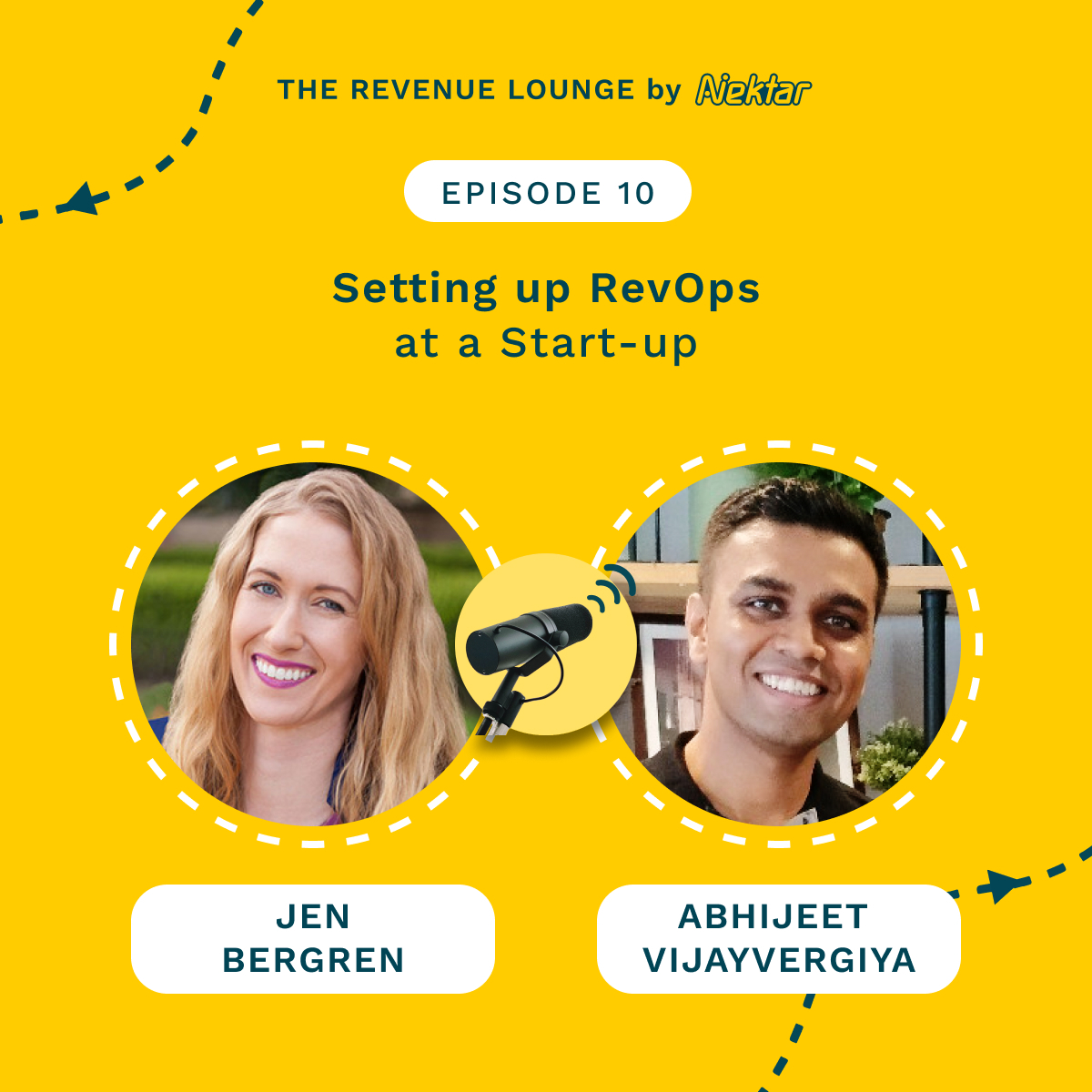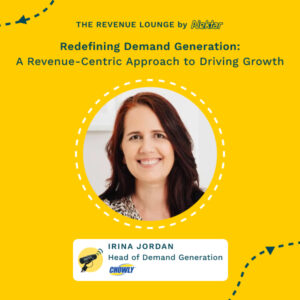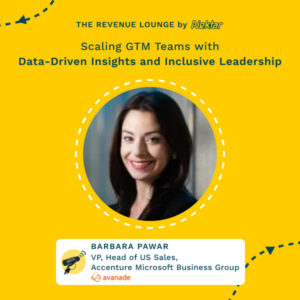Overcoming Data Challenges in Marketing: Navigating Privacy, Silos, and Insights ft. Liana Dubois
November 19, 2024
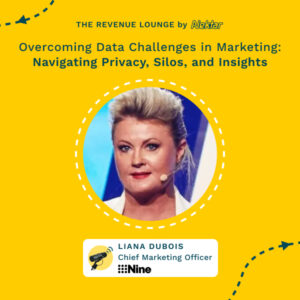
About
The Revenue Lounge
The podcast covers stories from leaders across RevOps, Sales, Customer Success, GTM, Data and Marketing about what drives these functions and what advice they would share with our listeners. With 3 seasons recorded, the podcast currently features 50+ enterprise leaders in the B2B SaaS domain. Tune in to hear from the best in the business
In this episode of the Revenue Lounge Podcast, host Randy Likas and guest Liana Dubois, Chief Marketing Officer at Nine, discuss the complexities of marketing data challenges. They explore the importance of integrating data across various platforms, understanding audience segmentation, and measuring campaign success. Liana shares insights on breaking down data silos, the significance of first-party data, and the future of personalized marketing in a privacy-first world. The conversation also touches on the ethical considerations of AI in marketing, balancing privacy with targeted marketing, and the critical role of creativity in influencing consumer behavior.
- Access to data is easier, but making sense of it is challenging.
- A customer data platform (CDP) is essential for integration.
- Understanding audience behavior is key to effective marketing.
- Measuring success requires more than just data points.
- Breaking down data silos is crucial for a unified view.
- First-party data is vital for effective marketing strategies.
- AI is a tool that requires ethical considerations.
- Creativity is essential in influencing consumer decisions.
- Targeting at scale is more effective than micro-targeting.
- Never assume; clarity in communication is vital.

Randy Likas (00:01.986)
While having access to data has become easier, making sense of it, ensuring its quality, and using it effectively has become increasingly challenging. From breaking down data silos to navigating shifting privacy regulations, marketing teams are constantly adapting to maintain customer trust while driving impactful campaigns. Hello everyone, welcome to the Revenue Lounge Podcast. I am your host, Randy Likus. And in this episode, we will dive into the complexities of overcoming marketing data challenges. We’ll discuss the future.
of personalized marketing and a privacy first world and the evolving role of first party data and shaping effective strategies. Joining me today is Liana Dubois. Liana is the Chief Marketing Officer at Nine, where she has held various leadership roles for the past 12 years. She’s also an advisory member in the Growth Committee for Women in Media Australia and a member of the Board of Advisors of Inclusively Made. Liana, thank you so much for joining us today.
Liana Dubois (00:58.669)
Thanks for having me, Randy. Awesome to be here to have a chat.
Randy Likas (01:01.762)
Yeah, I’m excited for the discussion. So usually what I like to do is start. And for those that might not be familiar with Nine, can you maybe give us a little bit of an overview of the company and then share a little bit about your background and your current role at Nine?
Liana Dubois (01:19.235)
For sure, so Nine is Australia’s largest locally owned media organisation.
We’re a multimedia business. We are the product of &A activity actually. So we have a very vast media platform that we like to refer to as kind of an integrated audience ecosystem. But what all of those buzzwords mean is we have channel assets that span the television media landscape, the audio media landscape, the publishing media landscape, and also we have marketplaces across
real estate and auto categories. And we have a subscription video on demand platform as well called Stan, which is Australia’s competitor to Netflix. So we have a sort of a vast channel mix. We are both an advertiser funded media organization, and we also have diversified revenues into the subscription landscape. My role here at Nine as Nine’s Chief Marketing Officer spans sort of a group remit.
had to write my role in one sentence it would be to grow commercializable audiences. That’s the job of the the group CMO here. My background is probably a little different to many marketers backgrounds actually. I’m marketing trained but actually this is my very first sort of what you would call client side role.
My history which spans, unfortunately or fortunately, 25 years in the media industry, actually started out in the commercial landscape. So I have had predominantly what you would know as sort of front-facing sales roles where it’s been my job to sell media inventory to marketers and advertisers, essentially. So selling TV, advertising, radio advertising, publishing, advertising, etc. So I spent the vast majority of my career
Liana Dubois (03:17.999)
commercialising media inventory which I think has set me up beautifully for now having the job of growing commercialisable audiences because I have an acute and very deep understanding of how media makes its money and you know marketing is a commercial role so you know understand having that sort of business acumen and that sales acumen has really has really helped to sort of set me up for success in this role. I’ve also held roles in sort of strategy
sponsorship integration so you know how you integrate brands in and around content and then I stepped into the CMO role I think near on two and a half years ago now so that’s my background.
Randy Likas (03:54.99)
Okay.
Randy Likas (04:01.986)
Fantastic. What a great diverse background that you have, especially coming from sort of the sales side of things. That gives you really good appreciation for what the teams go through to sell media and advertising. So I have a quick question. So with the presence across so many different platforms, how do you integrate data from those various sources, I guess, to build a cohesive strategy for advertisers?
Liana Dubois (04:27.971)
Yeah.
So great question. So we have a CDP or a customer data platform with Adobe and we use that CDP essentially to manage effectively, efficiently and privately. Of course, there is privacy and legislation that exists currently and it is actually changing in the very near future. But we use that CDP to manage the 22 million signed in users
users that we have across all of our platforms. So there’s 27, roughly 27 million people in Australia. We are small compared to the US, but we have 22 million of those 27 million Australians signed into any one of our platforms. And so that CDP is really, really imperative to us being able to understand in an anonymized way who those cohorts are, what they’re doing inside our integrated audience platform,
what they’re consuming, how long they’re there, what platforms they move around. If somebody’s a reader of say, the Sydney Morning Herald, they might also be a consumer or a watcher of Nine Now. So what shows are they watching? And that helps me as a marketer to be able to move consumers around that ecosystem. But from an advertiser’s point of view, it also helps advertisers to be able to segment and target more efficiently.
Randy Likas (05:34.766)
Yeah.
Liana Dubois (05:58.427)
and more effectively at scale.
Randy Likas (06:01.804)
Wonderful. And do you monetize the audience segmentation behavior different ways or is that all sort of packaged together for advertisers?
Liana Dubois (06:12.972)
the
That’s a really great question. So it really depends on how the advertiser is kind of viewing the world and what their challenges or opportunities are, you know, what impact they’re trying to drive for all of their campaigns. So some advertisers here in Australia very much take a kind of all people approach. So they don’t segment and they don’t target specific cohorts or specific niches. And, you know, that that is a fantastic approach for people, for marketers who are
trying to not only capitalise on existing demand but drive future demand with consumers that perhaps are not in market today but might be in market in the next three months, six months, 12 months, five years depending on the life cycle of your category.
But other advertisers, for example, they do want to segment, you know, and they want to attract specific cohorts. So they might like to, for example, go after lookalikes. So if they have their own first party data and they have their own customer sort of segmentation, they might like to go after lookalike consumers that have a similar makeup, but aren’t customers of theirs today, but have a similar makeup to, you know, cohorts in their in their existing customer base, because that feels like low hanging fruit to be able to
attract and bring over. Others like to suppress their current customer base obviously only go after those that aren’t or vice versa they like to suppress those that aren’t customers and re-engage their existing customer base and then others are you know segmenting in entirely different ways where they might be segmenting
Liana Dubois (07:50.187)
automotive intenders or you know, people with pets or real estate, you know, people looking for a mortgage or those sorts of things. So at nine, we have a number of partners in the data space that enable us to also understand not just media consumption behavior, which we know at scale, but also, you know, kind of other targetable kind of cohort behaviors.
that we might need to better understand. And so we commercialise in all of those different ways.
Randy Likas (08:26.542)
Yeah. In the green room, we talked a little bit about the challenge of too much data, right? Because there’s just, again, there’s just, you could look across all the different properties, there’s a lot of data. How do you determine what the right data is for driving effective marketing strategies?
Liana Dubois (08:35.256)
Yeah.
Liana Dubois (08:46.845)
such a good question and a question I’m actually really passionate about. So as I mentioned just before, as the CMO of nine, I have 22 million signed in users to my platform and that is a huge data set and it’s a wonderful data set to have.
but it’s only one part of the story. All that data is telling me is who I’ve got, how many I’ve got in an anonymized way and what they’re doing on my media platforms. It doesn’t tell me as the CMO whose job is to grow commercializable audiences. It doesn’t tell me why they’re with me. It doesn’t tell me what else they do when they’re not with me.
And you know, they’re really important, you know, data or insight capabilities for me to have to extract from elsewhere to be able to influence how I can get people to come to me more often and to spend more time with me and to get the remaining five million people in the country that aren’t with me to come. asking constantly, I’m constantly asking myself questions like, you know, okay, like I’ve got a huge spreadsheet
in front of me or a huge data set in front of me, what is the data that actually matters? And I don’t know if it’s the same in the US, I would hypothesize it probably is. You know, we’re in this industry in this country, we are, we fall a little bit victim, if I may, to treasuring what we measure today. You know, and there’s a lot of kind of legacy measurement constructs that exist, you know, like overnight ratings for television.
Randy Likas (10:19.799)
Mm-hmm.
Liana Dubois (10:22.891)
Overnight ratings for television really are just one tiny part of the picture, because obviously people are watching on demand in their own time, et cetera, et cetera. So we fall a little bit victim to treasuring what we measure rather than measuring what we treasure. And so I think it’s really important for other marketers to just ask yourself what is important for you to understand. Just because I have a 22 million person data set does not mean I have all of the answers with that data set.
Randy Likas (10:47.809)
on.
Liana Dubois (10:52.757)
in fact, far from it. And so, you know, just constantly being curious, what else can I learn? Where else can I get data and insight to either back up what I’m seeing or to help me unpack what I’m seeing. And that kind of curiosity piece for me, I think is really, really paramount.
Randy Likas (11:03.522)
Mm-hmm.
Randy Likas (11:11.311)
How do you measure the success of different campaigns and strategies that you’re employing?
you
Liana Dubois (11:25.411)
So the ways in which we measure today, and we’re on a journey of our own, finding better ways to measure what’s important to us. But some of the ways in which we measure today is in the audiences that we bring to our platform first and foremost. Does a television show deliver the audience that we require it to deliver in order to be able to maximize the commercialization of that product?
Does a reader come to the Sydney Morning Herald or the Age or the AFR? Does a listener come to our podcasts, to our radio station, to our streaming platform? So measuring explicit audience numbers. The other things of course that we measure are things like impressions and engagement, brand salience,
We’re very, very deep in brand tracking. The brands of Nines media assets in this country have been building equity in them for, I don’t know, our publishing, our oldest publishing brand is about 190 years of age. Our radio brands are roughly 90 odd years of age and our television brand is roughly 70. So, we’ve been a part of Australian culture for a very, very, very long time. And so, kind of mapping brand consistency or brand value is really important.
important. But largely, you know, when your job is to grow commercializable audiences, it’s our marketing efforts delivering those audiences much the same as for you know, an advertiser on our platform, you know, what’s an advertiser that you would know in the US like Maccas. So let’s go with Maccas. Maccas, the CMO of Maccas job globally is to grow their consumer base and grow their basket size and grow their grow their frequency of purchase.
it’s similar for me. And so, yeah, I think it’s really interesting to kind of unpack the similarities between what an advertiser of a brand like Maccas or Uber or Audi or any of those is doing is really, really similar to the same of a media organization.
Randy Likas (13:38.402)
Yeah. What about data silos? So I think data silos often just probably disrupt a lot of the marketing efforts that you have. How do you approach breaking down those silos as you’re trying to create sort of a unified view of the customer across all the different properties?
Liana Dubois (14:00.685)
Yeah, so we once were a very siloed media organization. So as I said to you in my kind of intro, Nine as a multimedia organization today is the product of &A activity. So we once upon a time, know, there were four actually standalone businesses. One was a television business, one was an audio business and one was a publishing business. And those businesses have all come together.
to unite to become the multimedia organization that we are today. But obviously through that &A activity there is a moment in time where you’re sort of just three or four businesses standing next to each other rather than being deeply, excuse me, being deeply integrated as one entity.
And so the CDP, the implementation of the Adobe CDP has been paramount to being able to create an integrated audience platform where we have a single view of our customer. It could not have been done without the implementation of a CDP. And, you know, my counsel, I guess, to any marketer who finds themselves in an organization where they have data silos, you know, having a CDP and getting yourself a single view of a customer is absolutely
absolutely paramount to being able to maximise the understanding that you have of your customer base and then be able to influence the basket size, if you will, the number of products that they’re consuming across your platform, the frequency in which they’re consuming those products, again, depending on the life cycle of your category. But really, really important that I can’t stress enough the importance of the CDP in enabling us to
have a single view of a customer, where I can now go, OK, I know that there’s people that are reading the Sydney Morning Herald that dabble in Nine Now. And these are the sort of content genres that they’re interested in watching from a television point of view. And so if I can target them with other pieces of content that are similar to those sorts of genres that they’re already engaging in, then possibly I can get them to spend more time over there and vice versa.
Randy Likas (16:14.016)
Yeah. Makes you wonder how you got through life before the CDP, right? It was just so probably so challenging before that. Out of curiosity, how long has the CDP been in production for you all?
Liana Dubois (16:30.047)
Yeah, so the CDP has actually only been stood up over the last 12 months in our organization. So we are getting a lot of really fresh understanding and new understanding. We’ve had some levels of…
Randy Likas (16:34.06)
Wow. Okay.
Liana Dubois (16:44.753)
some levels of data and insight historically and certainly the advertising market has been able to actually funnily enough the advertising market has actually been able to more effectively engage in our data capability than the marketing function inside nine has been able to until recently so I think that’s that’s probably a really interesting thing for your listeners to to understand.
But yeah, the last 12 months with the implementation of the CDP and also review of our MarCom’s capability, our whole MarTech stack has really started to aid us in being able to grow commercializable audiences into the future.
Randy Likas (17:30.226)
Let’s shift a little bit and talk about first party data. How has the shift towards first party data impacted your approach to marketing? And what steps have you taken to ensure data quality and relevance?
Liana Dubois (17:42.649)
Sure, so we are somewhat unique in the Australian landscape in that either by good luck or good management, probably a combination of the two, we have held first-party data capability for quite some years. For example, in our television business, when Nine Now, which is our AVOD platform, our advertiser funded video on demand platform, when that was originally stood up, when that was originally
created we made the decision to
force in the politest way a login requirement for people to be able to consume that content and that platform is now several years old. So and the same can be said for our publishing business and also for our audio business although it’s slightly further behind in its kind of life cycle of transitioning off sort of a traditional broadcast medium into a streaming medium. So first party data has always been well for a very long time has been really really important
to our business and you know the importance of it obviously is to give you the insights and the understanding of your customer base so that you can better service their needs and their requirements and their wants but really importantly done in an ethical and privacy based and sort of under the guidance of the legislation that exists here in Australia.
that first-party data capability is incredibly important both for me as the CMO of 9 but also for our advertising community. Particularly, know, while Google have made the choice not to sunset cookies anymore, the, or certainly for the time being, who knows, you know, the reality is that there are shortcomings all over the place in terms of cookie capability. Cookies are crumbling all over the place.
Randy Likas (19:34.813)
I’m
Liana Dubois (19:45.847)
whether they’re being sunsetted or not. And so I think for the advertising community it’s really important to be working with partners that have a first-party data capability because it’s going to make your marketing efforts much more effective and much more efficient, particularly if you are looking to target large or small cohorts of a particular type of person or a particular type of behavior.
Randy Likas (20:10.923)
Do you know with Google’s decision to not move forward or to Sunset Cookies? How do you feel? How do you see the the future of personalized marketing evolving, particularly with respect to privacy first frameworks?
Liana Dubois (20:27.147)
Yeah so the reality to the the answer for that question Randy is that I don’t actually think anybody really knows because nobody has a crystal ball. What I would say is whether or not cookies get sunsetted into the future or not kind of I think is irrelevant for the importance of first-party data.
First party data treated in an ethical and a privacy first based manner is going to continue to become more important for advertisers and for marketers into the future. Notwithstanding, because of privacy and legislation change, it is going to come with some probably increased challenges or rules, boundaries and limitations than has historically been the case.
That said, if marketers are working with organizations that have well constructed
privacy-first based, ethically based data practices, then they will be able to unlock incremental value for their own organisation in terms of their marketing efforts. But I would say, you know, I personally spend a lot of time with my chief data officer and also my general counsel, my legal team here at Nine, making sure that myself and my marketing team
Randy Likas (21:51.158)
Yeah.
Liana Dubois (21:57.367)
and also our commercial team who are interfacing with the advertising market are acutely aware of all of the changes coming and what that will mean for us because organizations could find themselves in some real hot water and some very expensive hot water if marketers and advertisers aren’t acutely aware of what their rules, boundaries and limitations are going to be. And so to any marketer out there who’s listening,
I would really strongly recommend that you go and make very, very, very good friends with your Chief Data Officer if you have one, otherwise become it, or your legal team and really encourage everybody to really, really deeply understand what your rules, boundaries and limitations are as it pertains to first party data.
Randy Likas (22:31.532)
Yeah.
Randy Likas (22:46.318)
You know, a little bit unrelated, but you bring up the relationship with legal and relationship with the chief data officer. In the world that we’re living in right now with AI and all the opportunities that AI is presenting itself, I think a lot of legal teams right now are, you know, they’re a little nervous, right? There’s some fear around what that might mean. any recommendations you have in terms of how to approach those conversations as it relates to AI with those constituents?
Liana Dubois (23:15.489)
Yeah and AI is another interesting one right? It’s new and it’s exciting on one hand and it’s mildly scary or challenging on the other. Again nobody has a crystal ball so nobody knows where this thing is going. That said my personal belief and I could be proven very very wrong which is a-okay but my personal belief is that AI is similar to other forms
of new technology that arrived over decades and decades and decades. It is a tool that will only ever be as good as its trades person and we’re all trades people using a tool. But I would hazard a guess that we are, if we’re not already in peak hype cycle for AI, we will very shortly be in peak hype cycle. In fact, we could have already been in it and we might be slowly falling into the trough of disillusionment before we will normalise like we have with any other.
every other piece of technology and it will just become sort of part of BAU and part of what we do.
but we flipped out and we doubt about the internet. We flipped out and we doubt about the arrival of data. We flipped out and we doubt about a whole pile of other technology advancements. And I’m not so sure that this one’s much different. But in terms of how we’re thinking about AI inside our business, it’s absolutely a tool for the using. It is already being used inside our organization. But we did set up very early on a sort of
guiding principles, if you will, or a kind of a philosophy about how we would approach AI. And we take a people first approach and a people last approach. So AI is a tool that is used in the middle, but we start with what is right, wrong or indifferent for our people. And we end with what is right, wrong or indifferent for our people. And we make conscious choices in terms of what we will and what we will not use it for.
Liana Dubois (25:24.132)
through a very human and people lens. And so I think when it comes to conversations with say your legal team around these sorts of things, if you have guiding principles and if you take a kind of people first approach, it tends to then take the sting out of the tail in terms of like the actual tool itself.
Randy Likas (25:35.575)
Hmm.
Liana Dubois (25:46.182)
because you’re doing what you would do with anything else and making conscious choices based on those guiding principles.
Randy Likas (25:56.14)
Yeah, I think that that’s an excellent framework. know, people first or people principles is an excellent advice. You know, there’s a lot right now around around. No, please, please go.
Liana Dubois (26:08.355)
Yeah, I think that’s, sorry, Randi. Sorry, was just gonna, thank you, I was just gonna build. One of the other things we talk about a lot, or rather is increasing in frequency in terms of the conversations we’re having internally is the sort of…
the notion of ethical choices. And I certainly believe that the rise of the Chief Ethics Officer may be a thing into the future.
you know, as more technologies and generative AI is one of them right now, but as more technologies, you know, kind of accelerate and pop into the world around us, I think, you know, the choices of, you know, that, that old question of just because you can doesn’t mean you should, I think becomes, starts to become more, more acute perhaps than it has before. I don’t know, but I would watch this space for the rise of the chief ethics officer.
Randy Likas (27:11.138)
Yeah, I wholeheartedly agree with that. Related to ethics in sort of the ethical officer, I think there’s a big movement right now, it’s not new, maintaining consumer trust or customer trust while delivering that personalized sort of marketing experiences is really a balancing act. How do you ensure the privacy is upheld while still creating targeted impactful campaigns that grow your audiences?
Liana Dubois (27:40.685)
Yeah, it’s a good one. In particular in media trust is I mean it’s paramount for every business of course but in media in particular when your role in society and culture is to educate, inform, entertain and you really do influence culture as a media organization it’s so incredibly important.
You know, globally, it is well recognized, unfortunately, that society’s trust in media and trust in news media is declining. And so I again, if there’s any if there’s any media colleagues listening, then I would challenge all of us to remind ourselves daily of our role in society as influences of culture. But in terms of the application of
marketing strategies that are underpinned by data and sort of how you can use it effectively without being kind of big brother is watching or stalking me around the internet. Again, I go back to you know, just because you can doesn’t mean you should take a people first approach. How do you, well you know, what’s your own consumer behavior? Be careful of surveys of one, but what is your own consumer behavior? What is a really helpful way for you to be targeted?
and a really unhelpful way for you to be targeted. If I’ve been searching the internet for a new black and white polka dot blouse and I’ve now found it and purchased it, why am I still being stalked around the internet by black and white polka dot blouses? We constantly are asking ourselves, is that actually a helpful way for our consumers to be targeted or is that an unhelpful way? And so we do talk a
Randy Likas (29:28.11)
Yeah. Yeah.
Liana Dubois (29:33.151)
both in terms of our own behaviors from a marketing point of view but also how we talk to advertisers in the market is targeting at scale rather than targeting really niche cohorts because I think when you get to micro targeting and niche like super super super small that’s when it gets creepy and that’s when it’s really unhelpful and it’s actually not a great way to grow your business anyway so targeting at scale and targeting larger cohorts I think is a better way in
Randy Likas (29:50.925)
Yeah.
Randy Likas (29:56.237)
Yeah.
Randy Likas (30:02.924)
Yeah, I would agree with that. And I think the more, I guess, minutiae that you get in that targeting, it impacts the overall experience, right? The customer experience as well, because they just don’t like it. And that’s sort of having the opposite effect, I think, of what you’re out for to begin with.
Liana Dubois (30:20.909)
Yeah, but it’s also, Randy, it’s not a good way to grow business.
Randy Likas (30:20.942)
You mentioned this-
Liana Dubois (30:26.469)
It’s not a good way to grow business because when you get to that kind of level of micro targeting and minutiae All you’re really all you’re doing is capitalizing on existing demand on the the five to maybe fifteen percent of Consumers that are in market for your product right now today Whereas you are not hitting the 85 to 95 percent of consumers that might be in market for your product in the next Month three months six months twelve months five years if you’re an auto
So like getting that balance right of existing and future demand is absolutely paramount and that I do see in Australia today and I suspect it’s probably the same in the US, it is the same in the UK, there is too much focus today on existing demand and short term and not enough focus on future growth.
Randy Likas (31:15.694)
It’s the same thing in the US, 100%. I want go back to something you mentioned earlier, which I think is related is, there’s a lot of real-time overnight ratings, I think is what you had mentioned, but there’s a lot of real-time data validation that you can have as part of your marketing efforts. How do you ensure that the data that you’re using is always up to date and reliable, or is there such a thing as too up to date?
Liana Dubois (31:19.149)
Yeah, I would have thought so.
Liana Dubois (31:47.767)
Ooh, that’s a goody.
So how do you ensure that it’s up to date? So there’s some really practical stuff. Let’s make sure that we’re working with partners and collaborators that actually do what they say on the team and they’re good at what they do for starters. Because I think there’s a lot of shonky providers out there. So let’s make sure that we’re choosing providers that actually have the capability and the skills to be able to support you with what you need.
go back to that kind of being curious all the time and asking questions and if you’re not sure what questions to ask, ask the people around you, reach out to colleagues, what you know other marketers, advertisers etc what’s the sort of stuff that I should be thinking about and let’s not anybody be worried about asking questions that they don’t know.
because everybody is on various different stages of understanding how to unpack all of these things, but be curious and ask questions. Why does the data show me this? Am I seeing, is this what I think the data is showing me? How has the data come to, what’s the methodology? How has the data come to light? How up to date is it?
Randy Likas (33:03.255)
Uh-huh.
Liana Dubois (33:04.235)
And then I do think there is, again, I go back to something I said earlier, I do think there is great risk in people being either overwhelmed by or confused by the amount of data that they have in their hands and not sure what is actually going to help them into the future. And so…
you know, practically surrounding yourself with people that can help you unpack that because no one person has got all the answers is probably the practical answer to the question.
Randy Likas (33:33.326)
Yeah.
Yeah, wonderful. I may have let this question out of the bag earlier, but I did want to ask, is there any particular opportunity or maybe the next big challenge for data-driven marketing in the media industry that you’re particularly excited about? We talked about AI, but is there anything besides AI that you’re particularly excited about or you think might present the next big opportunity?
Liana Dubois (34:06.617)
For me, the next big opportunity is one that has always existed. But again, it’s something I’m reasonably passionate about. In a world that seems…
that seems just hell bent to be honest in being more excited by and more interested in, and there’s much more conversation around things like technology and data and all of the sort of science and machine based stuff that exists in the industry. I actually would like us to go back to, and the opportunity I think we have is to go back to consumer behavior and people and humans and the reality and the fact that marketing exists
Randy Likas (34:35.458)
Yeah. Yeah.
Liana Dubois (34:49.209)
to influence human beings to do something to drive a commercial outcome. And the best way to influence human beings is through emotion and through creativity and storytelling. And what I would witness in our rush to adopt new technologies and to have data-driven marketing campaigns and all of those sorts of things, we forget humans and we forget creativity and we forget emotion. And the reality is that the impact of sort of, so from a comms point of view,
communications or an advertising point of view, the actual message, the story, the ad itself is responsible for around about 50 % of the impact of a campaign. So let’s have a renaissance for creativity and bring back the craft of creative and using creative to influence the emotions of humans to drive them to make a decision. Because while we would all like to believe that we are logical and pragmatic humans that make decisions based on facts and
research and all that kind of jazz it’s a lie that we’ve been telling ourselves if you speak to you know any any behavioral economics person anthropologists psychologists any anybody who specialize in in human behavior they will all tell you that human beings buy on emotion and we justify with fact so let’s go back and start investing in the power of creativity to change the fortunes of business because that’s
Randy Likas (35:53.929)
Yeah.
Liana Dubois (36:19.009)
you influence humans. Sorry that was a soapbox rant.
Randy Likas (36:23.318)
No, I loved it. Dead on. Absolutely. Okay, so last question before we transition to our lightning round. What haven’t I asked you about around data-driven marketing or any of the topics that we speak of that maybe I should have? Is there any particular, some that’s top of mind for you that I didn’t ask that maybe I should have?
Liana Dubois (36:53.283)
Well, I’ll probably, go back to my soapbox for a second.
The ability and the power of data and insight to help influence creative territories. Creative is I think a very misunderstood craft. There is a lot of instincts obviously and just general human understanding that goes into the creative craft, but in actual fact there is a lot of data and insight that goes into underpinning ideas and human thinking and the creative process.
the creative platform that those extraordinary creative minds can develop and come up with. So I think, you know, spending a little bit of time understanding the kind of insight that can be extracted from data, because data and insight are not the same thing, one feeds the other, the kind of insight that you can garner from data to be able to feed that creative process, to bring a renaissance to the craft and the ability for creative to change the fortunes of business, I think is it may be another podcast
cast for another day, Randy.
Randy Likas (37:57.644)
Yeah. So I know I said the last question, but you just said something that I would love to get your perspective on. So what is the difference between data and insight?
Liana Dubois (38:10.421)
So for me and I’m happy to be argued with or proven wrong but for me data is data is kind of a it’s the what and insight is more around the why and the how is probably the way that I would unpack that and you know data is a very sort of hard metric whereas insight takes into consideration
I think a broader world and obviously, you know, human behaviors and those sorts of things. But yeah, if data is the what, insight is the why and the how.
Randy Likas (38:51.502)
Someone once said to me, I asked the same question to someone and I love their answer, which is data is what it is. It’s data points. The connective tissue between the data is the insight. And I love that metaphor. Yeah. Okay. Great. Let’s turn into, let’s go to the lightning round, which is a little bit more personal. So we’d be curious just to ask you, what is the favorite part?
Liana Dubois (39:02.615)
Yeah, his insight. Yeah, nice. I like it. I’ll steal it with pride.
Randy Likas (39:20.078)
of being the CMO at NINE.
Liana Dubois (39:25.705)
Gosh the favorite part of being the CMO of nine is Is is actually to realize? the placing culture that our brands hold It’s quite a it’s quite a humbling experience
you know, when you are working with a house of brands that have existed for 190, 90 and 70 years and have been influencing culture for that period of time, that’s a, yeah, it’s quite a thing. It is quite a thing, quite extraordinary.
Randy Likas (40:02.094)
It really is. And such great heritage of the brands that you represent. I think you mentioned 193 years the Herald has been around. That’s incredible. Okay, so there’s always gonna be a flip side to that question. What is your least favorite? Or I would ask a different way, like what’s really hard about your job?
Liana Dubois (40:10.701)
Yep.
Liana Dubois (40:18.157)
What’s the worst?
Liana Dubois (40:25.657)
What is the worst?
Liana Dubois (40:31.233)
I’m not a big fan of administration and administrative tasks, but that probably feels, you know, that’s probably an every one thing. One of the most challenging things about being a chief marketing officer and I speak to CMOs all around the place and I feel like it’s a shared, it is a shared challenge and I’m sure not unique to the role of a CMO either by the way. But I think, you know, stakeholder management and taking people on
the journey is, you know, it can be a very, time consuming part of a role. Particularly, you know, if there is not a great depth of understanding of the role of what marketing is and does. And so, you know, a big part of, you know, your day might be spent helping people to understand what that is rather than actually just doing really great work. And so as I say, you know,
It’s a shared challenge of a CMO, I understand, and also probably not unique to the role of a CMO. But I think time and effort spent in education rather than actually doing is certainly an ongoing opportunity for improvement, is what I would say.
Randy Likas (41:55.264)
Any advice, so I would think of that as you’re taking people on the journey with you, there’s change that’s involved with that and managing that change. Any advice that you’ve learned over the course of your career in terms of how to do that best?
Liana Dubois (42:06.361)
Yeah.
Liana Dubois (42:15.553)
Yeah and look it’s definitely still, I don’t mind being really really honest with your listeners, it’s definitely still you know a learning because you’re surrounded by different people all day every day and so what works to take one person on a journey doesn’t work for another. But I try personally to approach things as collaboratively as I can and try to help people to understand what they might be gaining rather than
what they might fear that they’re losing. I think, you know, change management can be can be really, really difficult, usually because human beings fear what they what they don’t know, and they fear what they’re going to lose or what they perceive they’re going to lose, rather than focusing on the positive and what they stand to gain as a consequence of the change. There’s a great book, actually. It’s an oldie, but a goodie called Who Moved My Cheese, which is which is just a great book. Yeah, you remember?
Randy Likas (43:11.88)
yeah.
Yeah, I do remember.
Liana Dubois (43:15.387)
Just a great book about change management. if anybody hasn’t read it or reread it, it’s a goodie.
Randy Likas (43:24.29)
Yeah, it’s a classic for sure. Last question. Having hindsight is sort of being the benefactor of experience. Hindsight is what you gain from years of experience. What advice might you give to your younger self about what’s ahead of your career?
Liana Dubois (43:26.967)
Yeah.
Liana Dubois (43:49.433)
these are goody. So hindsight is often 20-20. What I continue to learn to this day, so this is not just advice for my young self, this is advice for myself right now today, is to never assume
Never assume there’s a saying which I won’t say on this podcast in the interest of keeping it clean. But assumption, you know, makes a out of you and me and
Randy Likas (44:17.718)
Yep. Yep.
Liana Dubois (44:21.95)
It’s an ongoing lesson I think probably for lots of people. To assume that everybody has the same understanding you do, to assume a job has been done, to assume anything is probably to set yourself and others up to fail. So never assume is my advice to my younger self.
Randy Likas (44:39.8)
Wonderful. And with that, we are going to wrap it. I could talk to you for another 30 minutes, but I know we’re coming up on the top of the hour here. So Liana, I want to thank you very much for your time, for your insight. I think this is going to be a great episode for our listeners. with that, I’ll say goodbye to the listeners. Thanks again for listening to the Revenue Lounge. We’ll see you next time.

Ep #1: Navigating the Downturn with a Hyperfocus on Productivity
Listen Now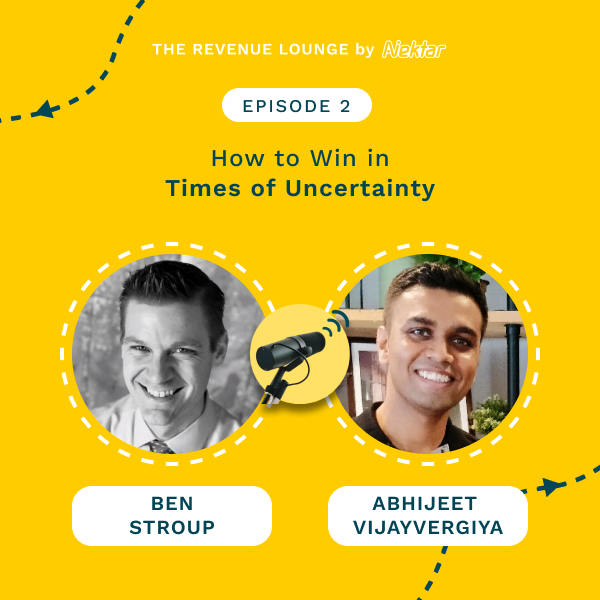
Ep #2: How to Win in Times of Uncertainty
Listen Now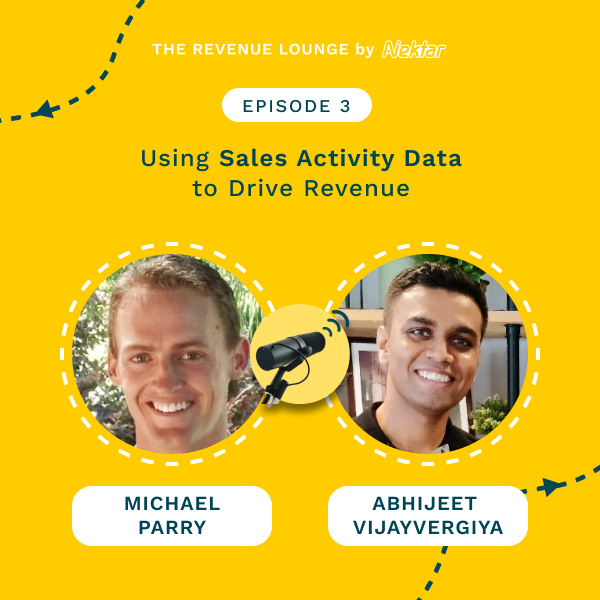
Ep #3: Using Activity Data to Drive Sales Productivity
Listen Now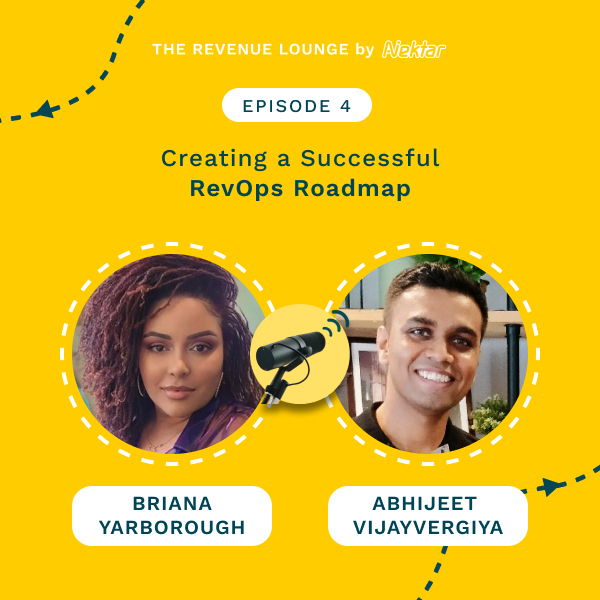
Ep #4: Creating a Successful RevOps Roadmap
Listen Now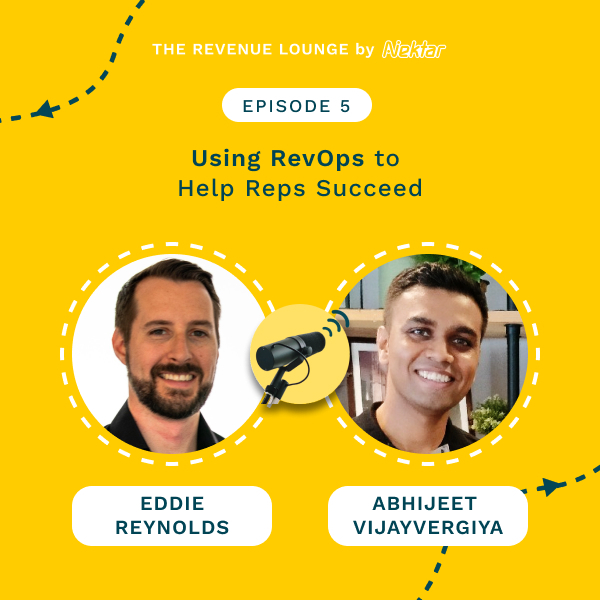
Ep #5: Using RevOps to Help Reps Succeed
Listen Now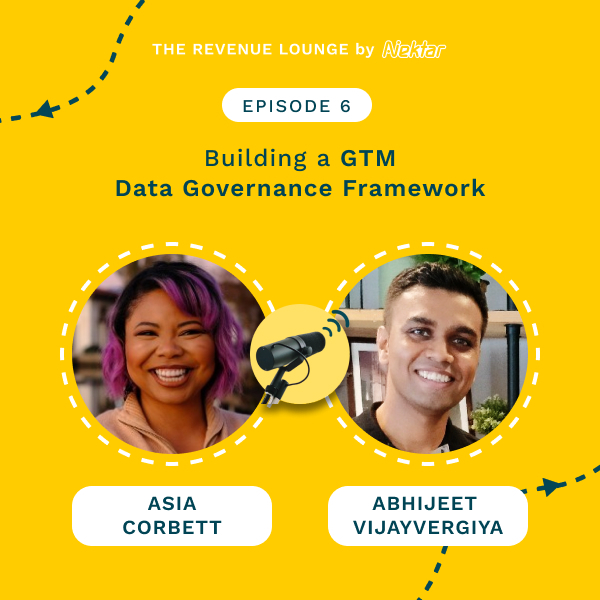
Ep #6: Building a GTM Data Governance Framework
Listen Now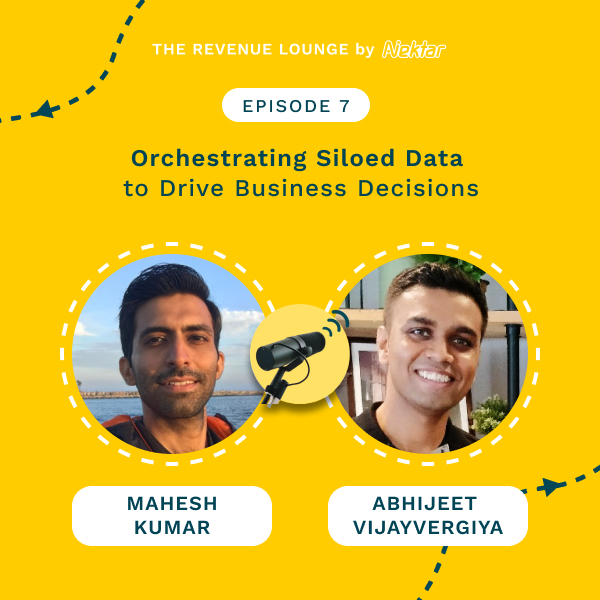
Ep #7: Orchestrating Siloed Data to Drive Business Decisions
Listen Now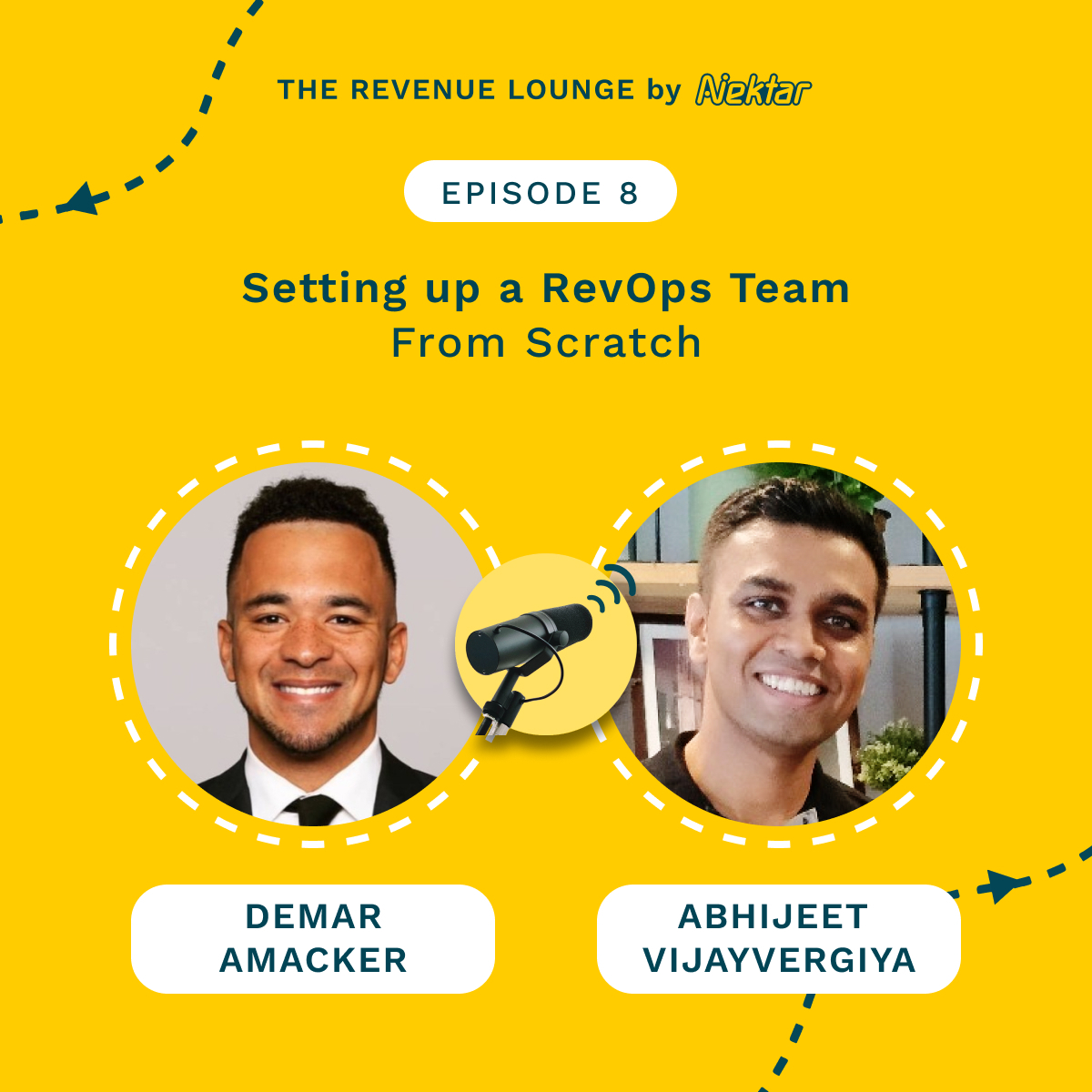
Ep #8: Setting Up a RevOps Team From Scratch
Listen Now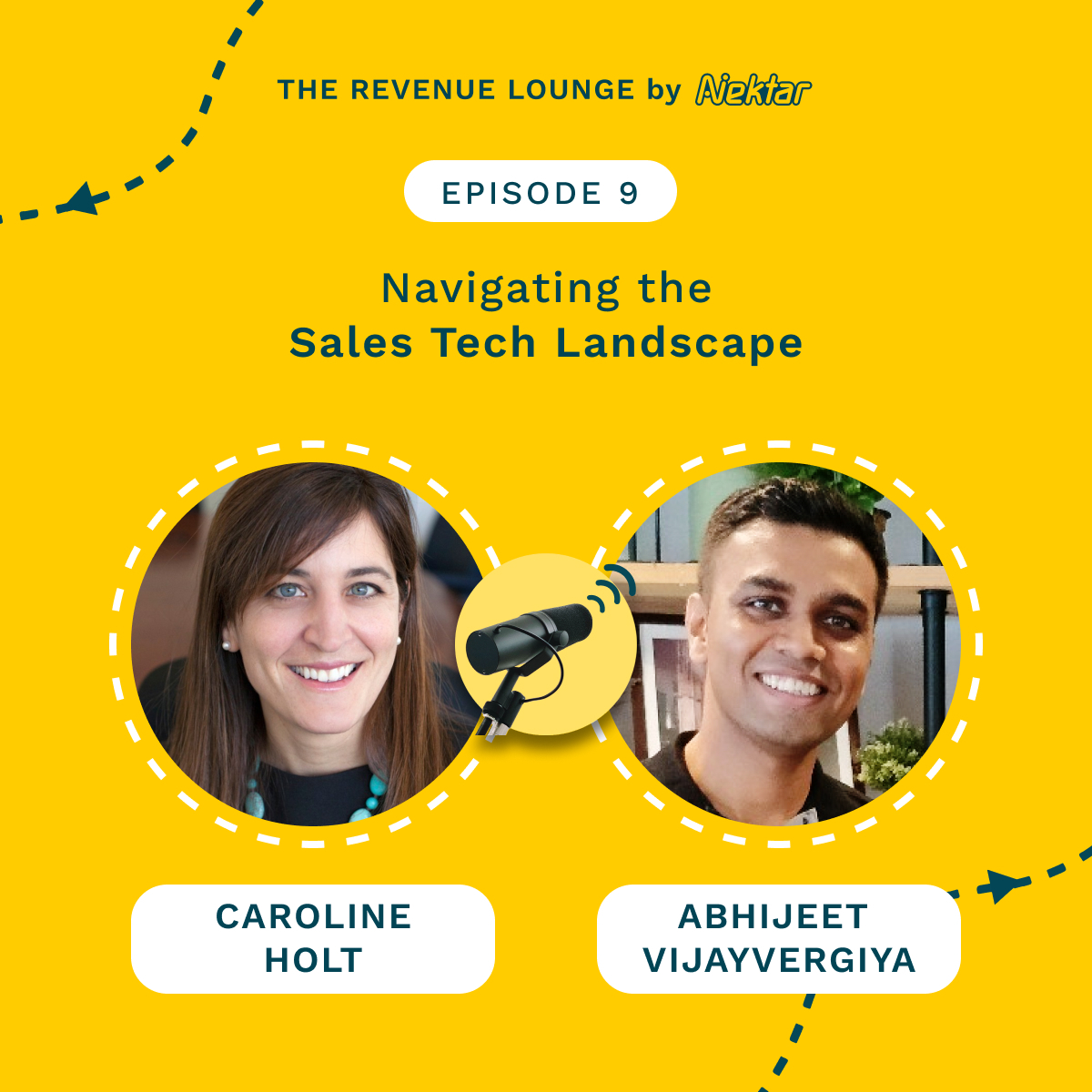
Ep #9: Navigating the Sales Tech Landscape
Listen Now